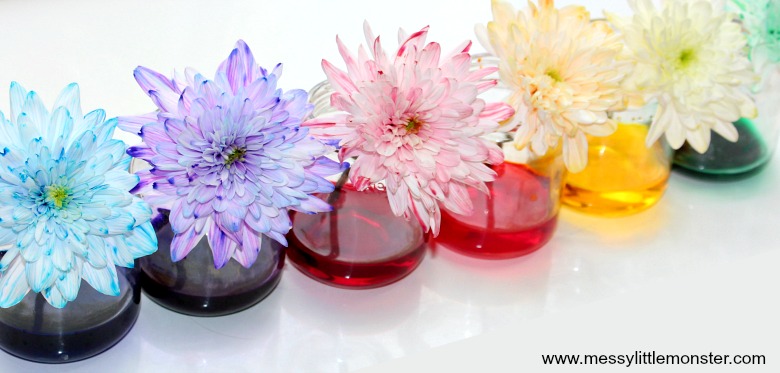Mother’s Day and National Creativity Day are almost here – which means it’s the perfect time to spend time together as a family, and what better way to do that than through fun and educational S.T.E.A.M. activities.
Parental involvement in a child’s life is so important for children of all ages as it aids them in:
- Building self-esteem and a positive sense of self-worth
- Strengthens family bonds
- Encourages communication
- Academic development
But most importantly, scheduling family time frequently means you can have fun and enjoy each other’s company!
Here are two fun and easy S.T.E.A.M. activities that encourage family time and bonding, for you to do with your #younginventor!

S.T.E.A.M. Activity 1
Color-Changing Flowers For Mother’s Day! 🌼

(source: messylittlemonsters.com)
Do you love getting flowers? This fun S.T.E.A.M. inspired activity for you and your child will create a unique and custom flower bouquet! This experiment will teach them about how plants get their nutrients while creating a beautiful arrangement of colorful flowers.
The Science Behind Color-Changing Flowers
Although it may look like magic to your #younginventor there is science behind why this happens! Because cut flowers have no roots, water moves from the cut directly into the stems. It travels up the stem through teeny-tiny tubes which deliver the nutrients to the other parts of the flower. Picture this, the stem is like the flower’s mouth which allows it to drink the water and get nutrients from the vase (or the ground if it’s outside). The food coloring that’s added to the vase, allows us to see this process in action.
While performing this activity, make sure to take a minute to explain this process to your child!
Let’s turn this fun activity into an experiment!💡
It’s time to make some predictions! Use this printable activity sheet to keep track of your child’s notes.
Ask Your Child:
- What do you predict will happen? Encourage your child to draw a picture of what they think will happen!
- Would anything change if we cut the stems shorter or longer? If so, what? Does it make a big difference?
- How quickly do you think the flowers will change colors?
- Draw a picture of what actually happened. What was different from what you thought would happen?
It’s Time To Make Your Colorful Flowers!🌼
Materials Needed:
- Fresh white flowers
- Pro Tip: Combine different types of flowers for a perfect bouquet!
- Clear glasses or plastic cups
- Food coloring (colors of your choice!)
- Scissors
- Paper towels, newspaper or placemats (in case of spills!)
Instructions:
- Trim the stems of the fresh white flowers at an angle. This allows the flowers to soak up the color easily
- Be careful: if your cups/glasses are smaller, cut more of the stem to make sure the flowers fit without falling over!
- Pour water into the glasses/cups until each is about halfway full
- Squirt a couple of drops of each food coloring into each glass/cup
- Pro tip: It’s best to have one color per glass/cup
- Place the stems into the glasses/cups
- Watch as your white flowers change colors!
- Pro Tip: The best results come from flowers that sit in the jars overnight! Have your child check on the flowers throughout the day to see the changes in the flowers.
S.T.E.A.M. Activity 2
Enjoy a S.T.E.A.M. Activity that’s bound to get your brain going for National Creativity Day!🧠💡
Unleash your creativity on May 30th for National Creativity Day! Let’s see what your family can come up with to problem-solve creatively!
Here’s a fun challenge to see who can come up with the most imaginative way to protect an egg! You can work together or be a team of 1 – It’s entirely up to you.
Egg Drop Challenge for Kids 🥚💡

(source: https://unsplash.com/@bailedelanguis)
Can your kids figure out how to drop an egg without it breaking? This is a fun opportunity to teach your little ones about creative problem solving and working together.
The challenge: build a device that will be able to hold an egg and protect it from breaking when it falls.
The Science Behind Eggs Cracking on Impact 💡
For adults it is almost common sense to expect an egg to crack when it falls, but for children this is an entirely new concept. Sir Isaac Newton’s third law of motion states that when two objects interact the force of their contact is equal in magnitude towards opposite directions. That means the ground is hitting the egg as hard as the egg is hitting the ground. If the concept is still shaky for your child, this is the perfect opportunity to let them learn for themselves!
Let’s Put On Our Thinking Caps!
It’s time to make some predictions! Use this printable activity sheet to keep track of your child’s notes.
Ask Your Child:
- What changes when different materials are used to protect the egg
- Will one material work better than others?
- Which material do you think will protect the egg best?
- Which egg do you think is definitely going to break?
It’s Time To Get Started!
Materials
What You’ll Need For The Experiment:
- Eggs
- 1 gallon sized Ziploc bags
- Paper towels
- Materials to protect egg
Recommended Material To Protect The Egg:
- Baking Flour
- Paper Towels
- Water
- Ice
- Dirt
- Egg Carton
- Old T-Shirt
- Whatever You Want To Choose – Don’t Be Afraid To Get Creative!
Pro Tip: Try to only use what you have in your house to avoid unnecessary spending. The quantity of materials depends on how many rounds of eggs you plan on dropping. If you’re not looking to use real eggs during the experiment to avoid a mess, feel free to use plastic eggs instead!
Instructions:
- Collect all materials you plan to use in the experiment.
- Prepare to assemble your egg drop devices.
- Grab one Ziploc bag and fill it with the desired amount of material you will use to protect the egg.
- Place the egg in the Ziploc bag in the optimal position to not crack.
- Repeat steps 3-4 for however many different Ziploc bags you plan on preparing to test your desired materials.
- Establish a drop point anywhere between 6-10 feet off of the ground where Ziploc bags won’t hit anything as they land.
- Drop first Ziploc bag from desired height.
- Record whether the egg cracked or survived the crash unharmed!
- Repeat steps 7-8 for all the Ziploc bags you’ve prepared.
- Discuss the results and post-experiment questions with your child – why may some eggs have cracked while others didn’t?
(Activity Inspired by Little Bins For Little Hands)

